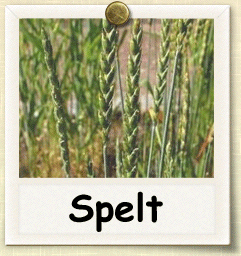|
Home > Guides > Grains > Spelt |
|
How to Grow Spelt | Guide to Growing Spelt |
|
|
|
|
| |
 |
|
Overview |
|
|
|
|
|
| |
|
| |
Spelt (Triticum aestivum var. spelta) is a sub-species of common wheat. It has been grown in Europe for about 300 years. Spelt was introduced to the United States in the 1890s.
Most of the nation's spelt acreage is in Ohio. That state grows between 100,000 and 200,000 acres of spelt annually, about 10 times more than any other state. A few varieties of spelt were developed in the early part of this century. They are no longer identifiable, and spelt has been considered an undeveloped crop. In 1986, The Ohio State University released an improved winter variety, named 'Champ'.
Spelt is often erroneously called "speltz." Sometimes emmer, another subspecies of wheat that includes dururn wheat, is incorrectly called spelt. |
|
| |
|
|
| |
Growing Guide
GROWING NOTES
The growth habits of spelt are similar to those of winter wheat. Spelt generally lodges less than soft red wheat, but more than semi-dwarf hard red spring or winter wheat. Under conditions where soft red wheat tends to lodge, spelt has produced more grain. Spelt has large pithy stems. As with oats, the hulls remain on the grain in threshing and comprise 20% to 30% of the grain weight. No official test weight has been established for spelt, but recent tests show that unhulled it averaged 28 lb/bu. The test weight of hulled seed is close to that of wheat (60 lb/bu).
Seedbed Preparation:
Soil preparation is the same as that for winter wheat.
Seeding Date:
The seeding date is the same as that for winter wheat - mid-September in the Upper Midwest.
Method and Rate of Seeding:
Spelt should be seeded with a drill set as for oats to plant 80 to 100 lb/acre. When the seedbed is dry, spelt should be seeded slightly deeper than winter wheat. The grain drill should be calibrated to ensure that the desired seeding rate is obtained.
Fertility and Lime Requirements:
Requirements for fertilization are similar to those for winter wheat. On soils with optimum or lower soil tests, apply a complete fertilizer with a combination drill at seeding time. Avoid direct contact of the fertilizer with the seed. An additional topdressing of nitrogen in early spring may improve yields. The topdressing should contain 10 to 20 lb less nitrogen per acre than for wheat; the straw of spelt is tall, and excess nitrogen can cause lodging. Common rates of nutrients to be applied are 50 to 60 lb/acre N, 25 lb/acre P2O5 and 30 lb/acre K2O. Apply lime to maintain soil pH at about 6.0.
MAINTAINING
Aside from some moisture to help the seed germinate (which won't take long), grains don't need to be watered. If there's an especially hot, dry day then feel free to provide some water: trickle tape or a drip irrigation system is ideal. Too much water will cause grains to grow too tall, at which point they may fall over (called "lodging").
|
|
| |
|
| |
Heirloom seeds are the gardeners choice for seed-saving from year-to-year. Learning to save seeds is easy and fun with these books. Before you harvest, consider which varieties you might want to save seeds from so that your harvesting practice includes plants chosen for seed saving. Be sure to check out our newest seed packs, available now from Heirloom Organics. The Super Food Garden is the most nutrient dense garden you can build and everything you need is right here in one pack. The Genesis Garden s a very popular Bible Garden collection. The Three Sisters Garden was the first example of companion planting in Native American culture. See all of our brand-new seed pack offerings in our store.
|
|
| |
|
|
| |
Harvesting Guide
HARVESTING
Spelt can be direct combined or windrowed and threshed similar to winter wheat. For direct combining, the moisture content of the crop should be 14% or less. If there are many weeds, the crop should be windrowed and the windrow allowed to dry for a few days. The crop can then be picked up and threshed with a combine fitted with a pick-up attachment. The combine should be adjusted in a manner similar to that for harvesting oats.
SAVING SEEDS
Collect seed heads as they dry on the plants and store in closed paper bags
to finish drying (many of the seeds will shed naturally). Chaff easily blows
away after seed heads are crumbled (watch for thorns or prickles in some
plants).
|
|
| |
|
|
|
| |
|
|
|
|
|
| Click the packs below to see some of our other wonderful products |
|
|
|
|
|
|
|